
hydrosun®紅外線光熱治療儀再現了太陽和濕潤大氣的結合,而其特色為僅產生波長780~1400 nm具深穿透性的水過濾紅外線-A (wIRA)光外,且不會產生紫外線 (UV)。
hydrosun®水過濾的紅外線-A輻射(wIRA)輻射器允許以高穿透深度和強度對人體局部組織加熱。獨特的操作原理包括在輻射路徑中使用密封的水過濾皿來吸收易被皮膚表層吸收的紅外線-B和-C光等大於1380 nm 的波長,同時亦可吸收位於944和1180 nm兩個不同且易被表面的皮膚層吸收而導致疼痛感/脫水甚至於灼燙傷的吸水性波長。在臨床上被廣泛應用於一般醫學、風濕病、運動醫學/骨科、耳鼻喉科、皮膚科及疼痛緩解等多項醫學領域。

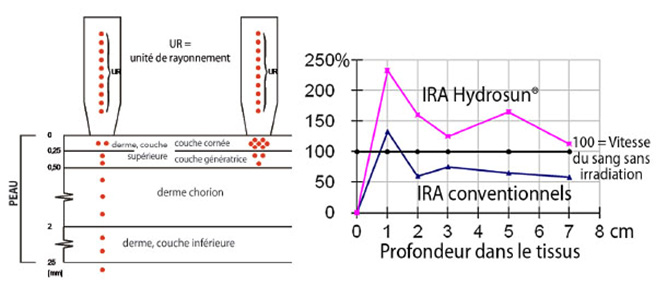
hydrosun®紅外線光熱治療儀
由於本儀器是由獨特且具專利的水過濾系統的組成,水過濾紅外線-A (wIRA)允許更長的曝光時間和更高的熱劑量。另外,由於hydrosun®紅外光熱治療儀的輻射對人體組織的穿透深度及強度遠超過一般常規的紅外線熱療設備。因此,利用更高的輻射強度,可以實現更長時間段內更深層組織的治療性加熱。
因此,水過濾紅外線-A (wIRA)允許:- 血流速度增加至7 ㎝深
- 深度及溫度升高但不造成表面皮膚過熱
hydrosun®紅外線光熱治療儀因配有獨特專利的水過濾皿,所以允許達成這些特異效應,而不同於傳統的紅外線熱療設備(IRC)。
傳統的紅外線設備(IRCs)僅發射未經水濾過的紅外線-B和-C,其在皮膚表面上燃燒,除容易導致疼痛感、燒燙傷和脫水現象等外,同時也無法增加血流速度以及提升深部組織的溫度。
(依使用環境需求,備有桌上型及支架移動型供選擇)
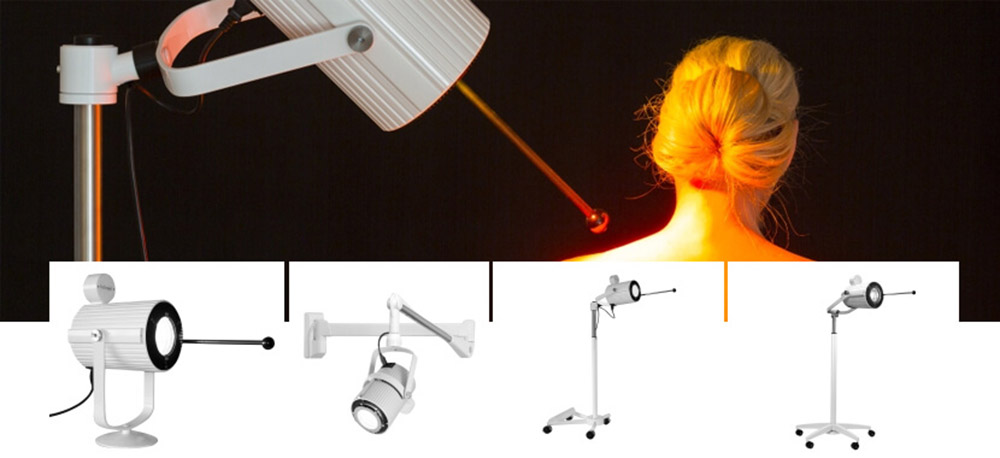
用途分類:
專業使用
在醫學專業組(醫師,物理治療師,足科醫師等)的使用領域,有hydrosun®575和hydrosun®750。這些型號的使用和應用是相同的。但在輸出功率、治療區域、電氣防護等級、外觀及重量方面彼此不同,並且:
- hydrosun®575 - 575W-鹵素燈 – 照射直徑 20 cm
- hydrosun®750 - 750W-鹵素燈 – 照射直徑 32 cm
* hydrosun®750建議用於較大的治療面積。
兩種設備均專為專業用途而設計。
家庭使用
如果對家庭醫療保健環境的hydrosun®設備感興趣,可選擇hydrosun®575home。 它符合國際標準IEC60601-1-11對家庭環境中使用的醫療電氣設備的要求。
hydrosun®575home含有575W-鹵素燈,其照射直徑為 20 cm。
産品概要
適用於hydrosun®紅外線光熱治療所有的設備:
- 為水過濾紅外線-A (wIRA)和可見光(VIS)的醫療設備
- 配有數字計時器和護目鏡
- 光譜: 400 ~ 1400 nm (水濾過),可調節的光學彩色濾波片* (如:標準橙色濾波片BTE595將光譜降低到 595 ~ 1400 nm )
光學彩色濾波片組合 - hydrosun®HC7
* 獨特的hydrosun®-wIRA (水過濾紅外線-A)光熱治療儀,可藉由選用光學彩色濾波片組合 - hydrosun®HC7(紫色→紅色)中不同顔色的濾波片來改變可見光譜的光照,同時進行wIRA熱和彩色光照的協同光熱治療而發揮其多功能性。它即將成為臨床應用不可或缺的輔助工具。所有的hydrosun®光學彩色濾光片均可傳輸紅外光。
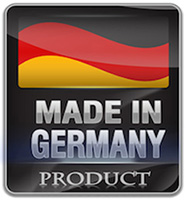
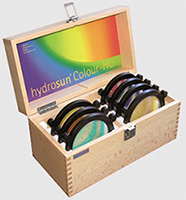

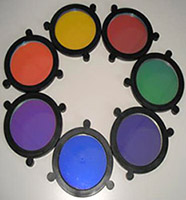
産品特長:
- 不會造成皮膚表層的過熱現象
- 不會造成皮膚的脫水
- 深層滲透和改善深層組織區域的循環
hydrosun®紅外線光熱治療儀使用者體驗:
- 提供無接觸式低熱量
- 減少保健費用
- 通過簡易的操作降低工作人員成本
- 可在任何房間使用,因為不需要耗材
- 運行和維護成本低
- 對照射區域進行溫和但強烈的深層加熱
- 對皮膚無過熱效應
- 沒有疼痛和燒傷問題,因為組織脫水很少
- 顯著改善,直到疼痛完全消失為止
- 明顯的肌肉鬆弛効果
- 比熱氣流更好,因為熱量的傳輸是「無脫水」「無接觸」
- 沒有冷卻效果,因為熱量被儲存於更深層的組織中
- 從輻射發射器到患者的距離被認為是令人特別舒適愉快的距離
- 適用於任何照射期
- 非常好的兼容性
hydrosun®紅外線光熱治療儀治療光景
參考文獻:
-
Aljasir A, Pierson T, Hoffmann G, Menke H:
Management of donor site infections in split-thickness skin graft with water-filtered infrared-A (wIRA).
GMS Interdiscip Plast Reconstr Surg DGPW 2018; 7: Doc03
https://www.ncbi.nlm.nih.gov/pmc/articles/PMC6007794/ -
König A, Missalla S, Valesky EM, Bernd A, Kaufmann R, Kippenberger S, et al.:
Effect of NIR photobiomodulation therapy in a cellular wound healing model.
Photodermatol Photoimmunol Photomed 2018. Accepted Article
https://onlinelibrary.wiley.com/doi/abs/10.1111/phpp.12390 -
Hoffmann G.:
Water-filtered infrared-A (wIRA) overcomes swallowing disorders and hypersalivation – a case report [bilingual].
GMS Ger Med Sci. 2017; 15: Doc11.
https://www.ncbi.nlm.nih.gov/pubmed/28794695 -
Hoffmann G, Hartel M, Mercer JB:
Heat for wounds – water-filtered infrared-A (wIRA) for wound healing – a review.
GMS Ger Med Sci. 2016; 14: Doc08.
https://www.ncbi.nlm.nih.gov/pmc/articles/PMC4928028/ -
Knels L, Valtink M, Piazena H, Marin JV, Gommel K, Lupp A, Roehlecke C, Mehner M, Funk RH:
Effects of Narrow-band IR-A and of Water-filtered Infrared A (wIRA) on Fibroblasts.
Photochem Photobiol. 2016 May; 92(3): 475-87
https://www.ncbi.nlm.nih.gov/pubmed/26876482 -
Barolet D, Christiaens F, Hamblin MR:
Infrared and skin: Friend or foe.
J Photochem Photobiol B. 2016; 155: 78-85.
https://www.ncbi.nlm.nih.gov/pubmed/26745730 -
KuenzliBM, Liebl F, Nuhn PH, Schuster T, Friess H, Hartel M:
Impact of Preoperative Local Water-Filtered Infrared-A (wIRA) Irradiation on Postoperative Wound Healing – A Randomized Patient- and Observer Blinded Controlled Clinical Trial.
Annals of Surgery. 2013; 258(6): 887-94.
https://www.ncbi.nlm.nih.gov/pubmed/24169161 -
Marti H, Blenn Ch, Borel N:
The contribution of temperature, exposure intensity and visible light to the inhibitory effect of irradiation on acute chlamydial infection.
Photochem Photobiol 2015; 153: 324-333.
https://www.ncbi.nlm.nih.gov/pubmed/26513384 -
Al-Ahmad A, Bucher M, Anderson AC, Tennert C, Hellwig E, Wittmer A, Vach K, Karygianni L:
Antimicrobial Photoinactivation Using Visible Light Plus Water-Filtered Infrared-A (VIS + wIRA) Alters In Situ Oral Biofilms.
PLoS ONE 2015; 10(7): e0132107.
https://journals.plos.org/plosone/article?id=10.1371/journal.pone.0132107 -
Schumann H, Calow T, Weckesser S, Müller ML, Hoffmann G:
Water-filtered infrared-A (wIRA) for the treatment of chronic venous stasis ulcers of the lower legs at home – a randomized controlled blinded study.
Br J Dermatol 2011: 165: 541–551.
https://www.ncbi.nlm.nih.gov/pubmed/21574975 -
von Felbert V, Kernland-Lang K, Hoffmann G, Wienert V, Simon D, Hunziker T:
Irradiation with water-filtered infrared-A (wIRA) plus visible light improves cutaneous scleroderma lesions in a series of cases.
Dermatology 2011: 222: 347–357
https://www.karger.com/Article/Pdf/329024 -
Wilsmann-Theis D, Bieber T, Novak N:
Photodynamic Therapy as an Alternative Treatment for Cutaneous Sarcoidosis.
Dermatology 2008; 217: 343-346.
https://www.ncbi.nlm.nih.gov/pubmed/18799881 -
Hartel M, Illing P, Mercer JB, Lademann J, Daeschlein G, Hoffmann G:
Therapy of acute wounds with water-filtered infrared-A (wIRA) Review Article.
GMS Krankenhaushyg Interdiszip. 2007; 2 (2): Doc53.
https://www.ncbi.nlm.nih.gov/pubmed/20204084 -
Hoffmann G:
Principles and working mechanisms of water-filtered infrared-A (wIRA) in relation to wound healing. Review Article.
GMS Krankenhaushyg Interdiszip 2007; 2(2): Doc54.
https://www.ncbi.nlm.nih.gov/pmc/articles/PMC2831244/ - Gebbers N, Hirt-Burri N, Scaletta C, Hoffmann G, Applegate LA:
Water-filtered infrared-A radiation (wIRA) is not implicated in cellular degeneration of human skin.
GMS Ger Med Sci. 2007; 5: Doc08.
https://www.ncbi.nlm.nih.gov/pubmed/19675716 - Möckel F, Hoffmann G, Obermüller R, Drobnik W, Schmitz G:
Influence of water-filtered infrared-A (wIRA) on reduction of local fat and body weight by physical exercise.
GMS Ger Med Sci. 2006; 4: Doc05
https://www.ncbi.nlm.nih.gov/pmc/articles/PMC2703221/



